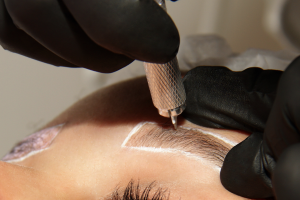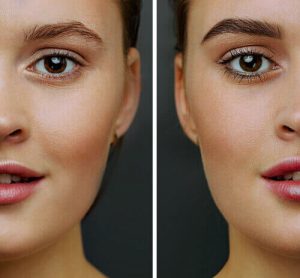
Eyebrows have been in the spotlight more than ever recently, and for good reason. Well-groomed brows act to frame the eyes and highlight your best features. In fact, groomed brows can make you look put-together on a makeup free day. This is why we spend so much time (and money) plucking, waxing, threading and filling them in. For this reason microblading, with its low-maintenance and semi-permanent appeal, has quickly become a go-to beauty treatment for women looking to obtain perfectly shaped and filled in eyebrows with little to no effort.
Curious to know if microblading is right for you? We gathered everything you need to know before microblading your eyebrows.
1. There are things to avoid before Microblading.
Avoid scheduling your appointment 30 days before or after any injectable filler treatments. Avoid any sun exposure, as well as tweezing, waxing or threading your eyebrows for at least one week prior to your appointment. Please avoid any alcohol, Advil or caffeine for one day prior to your service. These thin the blood, which can affect pigment retention. If you are feeling flu-ish it is best to avoid treatment. Clients may be more sensitive during their menstrual cycle.
2. It uses the same technique as a traditional tattoo, but they’re not the same.
Similarly to getting a tattoo, microblading uses a small blade to deposit pigments on your skin. Microblading is a manual tattooing technique designed to create natural hair-like strokes. The difference between microblading and traditional tattooing is generally the depth of pigment placed in the skin. When done correctly, microblading pigments are designed to break down over time, allowing them to completely fade away. Traditional tattooing is done using a machine and is generally designed to work deeper in the skin, creating a brow that will last longer over time.
3. It’s a two-part process.
The initial appointment is generally two to two-and-a-half hours long. Following the initial appointment we ask our clients to come back for their first touch up appointment six to eight weeks later to see how the skin has healed (as everyone heals differently). At that point we can make any adjustments needed such as color and density. The touch up appointment is usually one to one-and-a-half hours long.
4. Pain levels differ.
Pain levels differ from person to person, however, most of our clients find the procedure to be quite comfortable. We’ve even had many clients fall asleep during their microblading or permanent eyebrow session. Most clients would compare the feeling to tweezing or threading. Topical numbing cream is applied prior to any permanent makeup procedures, and a secondary numbing cream is applied throughout the treatment.
5. Microblading is not for everyone.
It’s important to note that not everyone is a good candidate for microblading. Women who are pregnant or nursing will not be good candidates. In addition, those undergoing chemotherapy are recommended to finish treatment as the risk of infection could be much greater. Those being treated by a physician or taking medications such as blood thinners are recommended to speak with their doctors to make sure the procedure is right for them. Someone who has had previous microblading done, which is still quite dark, may not be a candidate at this time. If this is you, and you are hoping to book, please email a photo to info@maryamcollahi.com to see if we can work over it. Microblading removal treatment may be required before any further permanent makeup.
6. Your skin type can affect results.
Microblading can definitely benefit certain skin types better than others, so it’s important to do your research and find the right technique for you. Drier skin types have the best results as the skin tends to retain pigment the best and keep the crispest strokes. Oilier skin types will work as well, but tend to heal a little softer and less crisp, possibly due to more oils in the skin.
7. Brows will fade after the first week and up to a month to fully heal.
If you’re afraid that your brows will look too dark or unnatural after a session of microblading, there’s no need to panic as this is a normal part of the healing process. Your eyebrows will look darker during the healing period, but the ink will not look as dark after this time frame.
The colour will fade up to 30-50% as it heals and will slightly shrink in size. In the following days you will notice slight scabbing. Do not pick at the scabs as this will damage your skin and the outcome of the pigment.
Your eyebrows will lighten up in colour as it heals. It takes about 7-14 days for the brows to heal over, and one month for the colour to fully set in.
You’ll notice the colour is very light right after two weeks; the skin will have an opaque milky looking quality to it. Often known as “milk skin” and is part of the healing process. This happens as tissue is still healing from the inside, even though the surface of the skin has healed. The actual colour will reveal itself once healed. The healing process can take a full month, as it takes the skin about a complete 30 days to regenerate. Generally speaking, the 30-day mark is when the true color will show itself.
8. Your microblading artist can make or break your look.
When deciding on an artist, it’s important to do your research. When researching an artist, there are a few other important factors to keep in mind—and safety is an important one. In addition to credentials and cleanliness, we recommend researching your artist’s work. It’s important to see not only before and after, but healed photos, as well. Choosing a well-trained artist is not only important for safety, but also for your entire microblading experience.
9. Invest in an artist who suits your style.
It’s no secret that microblading is an expensive treatment. The price will range depending on location and demographics. We recommend doing your research and investing in an artist who best suits your style. We completely respect that everyone will have a different budget and some artists are more expensive than others, honestly take your time and save if you need to. Microblading can end up costing you more if you end up not being happy with your artist’s work, and then having to remedy it with microblading removal treatments.
10. Follow after-care instructions for best results.
We generally advise our clients to apply the supplied healing ointment very minimally for one week. You want the area to be lightly moisturized. The treated area is basically an open wound, so you want to protect it from any bacteria. Avoid sun exposure, makeup, sweating, steam, swimming pools and even touching the area for one week other than applying ointment (with clean hands or a cotton swab). Always avoid laser treatments over the area, as this can destroy the pigments and cause burns. After the area is healed (7-10 days), you want to keep the pigment fresh by protecting it from the sun (shading the area or wearing SPF). You will also want to avoid using any retinol based products, as these will fade your cosmetic tattoo.





